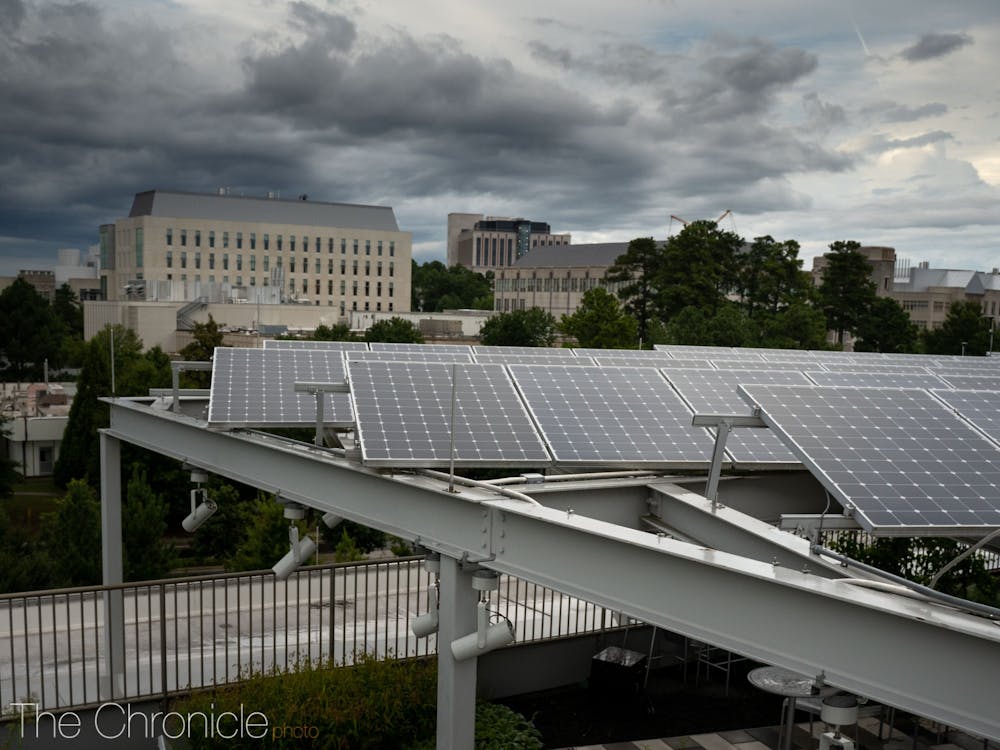A major solar acquisition over the summer, along with a new Board of Trustees strategic task force will help Duke continue on its path to carbon neutrality.
With Duke’s climate plan including extensive carbon offsets—projects meant to “cancel out” emissions being produced on campus—in addition to directly lowering emissions, the University partnered with a renewable energy company on a major solar project.
Over the summer, Duke purchased 101 megawatts of solar energy capacity from three solar facilities managed by North Carolina-based Pine Gate Renewables. Combined with existing plans, Duke hopes that the solar farms—which will be completed by 2022—will generate about half of Duke’s annual electricity and decrease the University’s carbon emissions by more than 70% by 2024.
The solar projects will not be on campus, according to Duke. Building them elsewhere will let the University build enough solar infrastructure to produce 20 times more power than it could on campus under current regulations.
“The solar power purchase was always in the books and an essential part of the plan, we’ve just finally made some progress on that, which is nice to hear given North Carolina’s restrictions on third-party energy purchases,” said Cameron Oglesby, president of the Duke Undergraduate Environmental Union.
The solar purchase is also accompanied by the creation of a new Board of Trustees strategic task force meant to outline further steps for environmental sustainability and climate change. The task force—which meets four times a year—consists of 22 members, including two undergraduate and two graduate student members, and met for the first time in late September.
“In their most recent meeting, the Board of Trustees Climate Change and Sustainability task force indicated that the University is still on track to reach its goal of 78% carbon emission reduction,” said Oglesby, who sits on that task force. (Oglesby is also graphics editor for The Chronicle.)
Prior to the solar power purchase, Duke had a long history progressing toward its goal of becoming carbon neutral.
Duke’s journey to environmental consciousness took a step forward in 2007 with the American College and University Presidents’ Commitment, which set a lofty goal to eliminate carbon emissions on campus by 2024.
In 2009, the University created the Climate Action Plan (CAP) which provided guidelines and solutions meant to inform campus policy decisions. The CAP also includes carbon offset recommendations, namely the Duke Carbon Offsets Initiative (DCOI), which was created in June of 2009.
DCOI generally buys up existing carbon offset projects and starts new ones as part of its carbon offset plan. Carbon offsets are meant to help get Duke closer to carbon neutrality, given that the school will still produce some emissions even with some transitions to cleaner energy.
Since the CAP’s creation in 2009, the university has made significant strides towards increased sustainability, including a 24% decrease in carbon emissions as of 2018. The CAP was revised a decade after its creation with a plan meant to fast track carbon emissions reductions from 24% to 78% within the next four years, with the rest accounted for via offsets.
The revised 2019 proposal acknowledged the need for bigger institutional changes beyond just carbon offsets that can produce long-term results. The solar farm is one such example.
Student organizations are also doing their part to contribute positively to campus sustainability efforts.
“Campus groups like the Undergraduate Environmental Union and the Duke Climate Coalition are currently engaging in research on things like biofuel to make sure that when these decisions are being made they are equitable,” said Oglesby.
Get The Chronicle straight to your inbox
Sign up for our weekly newsletter. Cancel at any time.

